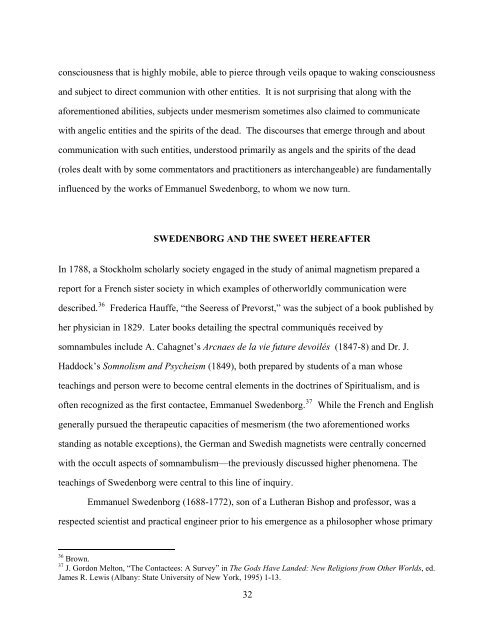A Genealogy of the Extraterrestrial in American Culture
A Genealogy of the Extraterrestrial in American Culture
A Genealogy of the Extraterrestrial in American Culture
You also want an ePaper? Increase the reach of your titles
YUMPU automatically turns print PDFs into web optimized ePapers that Google loves.
consciousness that is highly mobile, able to pierce through veils opaque to wak<strong>in</strong>g consciousness<br />
and subject to direct communion with o<strong>the</strong>r entities. It is not surpris<strong>in</strong>g that along with <strong>the</strong><br />
aforementioned abilities, subjects under mesmerism sometimes also claimed to communicate<br />
with angelic entities and <strong>the</strong> spirits <strong>of</strong> <strong>the</strong> dead. The discourses that emerge through and about<br />
communication with such entities, understood primarily as angels and <strong>the</strong> spirits <strong>of</strong> <strong>the</strong> dead<br />
(roles dealt with by some commentators and practitioners as <strong>in</strong>terchangeable) are fundamentally<br />
<strong>in</strong>fluenced by <strong>the</strong> works <strong>of</strong> Emmanuel Swedenborg, to whom we now turn.<br />
SWEDENBORG AND THE SWEET HEREAFTER<br />
In 1788, a Stockholm scholarly society engaged <strong>in</strong> <strong>the</strong> study <strong>of</strong> animal magnetism prepared a<br />
report for a French sister society <strong>in</strong> which examples <strong>of</strong> o<strong>the</strong>rworldly communication were<br />
described. 36<br />
Frederica Hauffe, “<strong>the</strong> Seeress <strong>of</strong> Prevorst,” was <strong>the</strong> subject <strong>of</strong> a book published by<br />
her physician <strong>in</strong> 1829. Later books detail<strong>in</strong>g <strong>the</strong> spectral communiqués received by<br />
somnambules <strong>in</strong>clude A. Cahagnet’s Arcnaes de la vie future devoilés (1847-8) and Dr. J.<br />
Haddock’s Somnolism and Psycheism (1849), both prepared by students <strong>of</strong> a man whose<br />
teach<strong>in</strong>gs and person were to become central elements <strong>in</strong> <strong>the</strong> doctr<strong>in</strong>es <strong>of</strong> Spiritualism, and is<br />
<strong>of</strong>ten recognized as <strong>the</strong> first contactee, Emmanuel Swedenborg. 37<br />
While <strong>the</strong> French and English<br />
generally pursued <strong>the</strong> <strong>the</strong>rapeutic capacities <strong>of</strong> mesmerism (<strong>the</strong> two aforementioned works<br />
stand<strong>in</strong>g as notable exceptions), <strong>the</strong> German and Swedish magnetists were centrally concerned<br />
with <strong>the</strong> occult aspects <strong>of</strong> somnambulism—<strong>the</strong> previously discussed higher phenomena. The<br />
teach<strong>in</strong>gs <strong>of</strong> Swedenborg were central to this l<strong>in</strong>e <strong>of</strong> <strong>in</strong>quiry.<br />
Emmanuel Swedenborg (1688-1772), son <strong>of</strong> a Lu<strong>the</strong>ran Bishop and pr<strong>of</strong>essor, was a<br />
respected scientist and practical eng<strong>in</strong>eer prior to his emergence as a philosopher whose primary<br />
36 Brown.<br />
37 J. Gordon Melton, “The Contactees: A Survey” <strong>in</strong> The Gods Have Landed: New Religions from O<strong>the</strong>r Worlds, ed.<br />
James R. Lewis (Albany: State University <strong>of</strong> New York, 1995) 1-13.<br />
32















